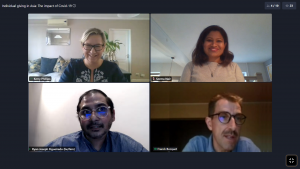
19 November 2021 | News and Updates | Seema Nair
IFC 2021 Recap: Individual Giving in Asia

During the recent International Fundraising Conference 2021, we teamed up with Franck Bocquet from UNHCR to discuss key themes around individual giving and how the COVID-19 crisis and recovery are shaping regular giving trends in Asia, specifically Malaysia, South Korea, Thailand, and Philippines.
2021 was the year of transition. While new waves of COVID-19 are still a threat, the availability of vaccines and the experience of the last 18 months mean society may begin to look forward to building their futures rather than simply surviving the present. The next normal will likely be different and may not allow for a return to the conditions that prevailed in 2019.
In our session, we shared data trends which reinforced the resilience of Face-to-Face as a sustainable acquisition channel along with the importance of making data-driven decisions to future-proof nonprofits’ retention programs.
No major differences in recurring donor’s survival rate
We compared retention data from donor cohorts who were acquired in the pre-COVID years to those acquired between 2020 to 2021 to determine if there was on impact on survival rates of regular give donors.
The donor survival rate analysis for retention helps charities understand how many donors continue to be active givers in the years that follow.
Channel diversification is integral to safeguarding against major disruption
There is no turning back. The rapid use of technology, digitisation, and new fundraising channels is expected to continue.
COVID-19 has accelerated non-profits’ transformation in areas like digitisation by many years. That transition has not always been a smooth or graceful one, with charities scrambling to install or adapt new technology under duress. The near-term issue, then, is to shift from reacting to the crisis to establishing and institutionalising what has worked thus far – which may imply enhancing digital and omnichannel fundraising approaches.
The disruption to Face-to-Face made it necessary for charities to restructure their operations – as well as a chance to reform them. During our session, we highlighted the drops of acquisition volume and subsequent rebounds in key markets as countries went in and out of lockdown. Charities which had an existing multi-channel strategy were generally able to continue fundraising despite movement restrictions.
Pandemic-induced changes in charitable giving behaviour
We also looked at the beginnings of what could be longer-term changes to donor behaviour and the regular giving donor profile across several markets. In analysing donor profiles, we look at variables such as average age, average gift and payment type to predict Lifetime Value (LTV) and average projected lifespan. While it is too soon to draw conclusions, the lesson here is for charities to observe the data, identify opportunities and threats, and respond through improved retention programs which address these areas.
This is not a comprehensive assessment on the pandemic’s undeniably catastrophic impact, but rather a review of patterns reflected in our data, which we believe will provide deeper insights into how the fundraising, service delivery, and larger nonprofit landscapes are evolving.
In some respects, we feel that the next normal may be improved. The developments we highlighted – in digitisation, payment processing, and resiliency – may offer a long-term basis with excellent leadership from charities.
If you’d like to find out more about future giving trends in Asia, reach out to us at consulting@sgsupport.com.




